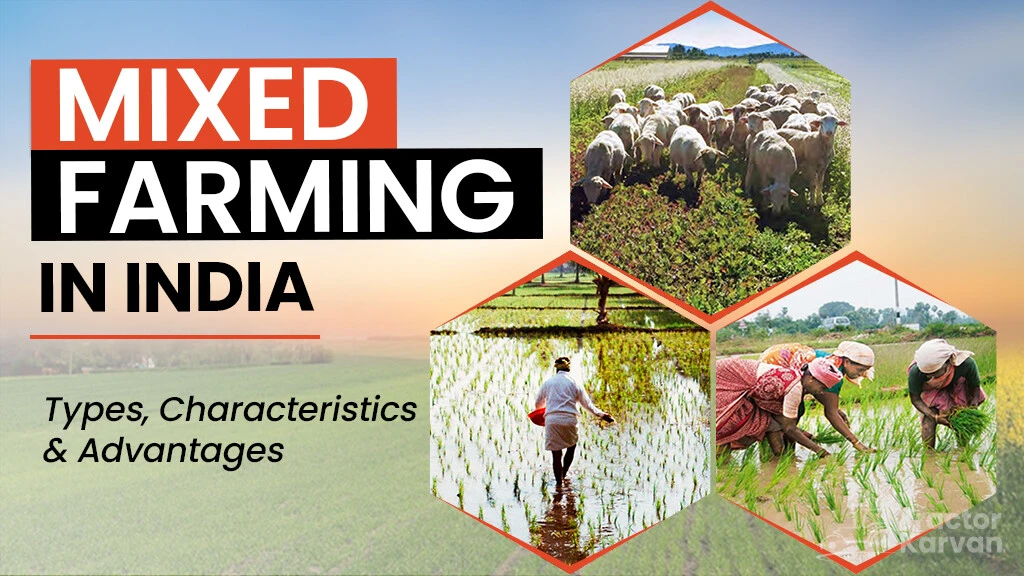Mixed Farming in India – Types, Characteristics and Advantages

Table of Contents
- What is Mixed Farming?
- What is the Need for Mixed Farming in India?
- What are the Advantages of Mixed Farming?
- What are the Characteristics of Mixed Farming?
- What are the Different Methods of the Mixed Farming System?
- What is the Status of Mixed Farming in India?
- What are the Challenges of Mixed Farming?
What is Mixed Farming?
Mixed farming is a practice in which multiple farm activities take place in addition to raising crops on a single piece of land. A crop can be grown along with farming activities like livestock rearing, beekeeping, fisheries, poultry, etc. The objective is to create as many sources of subsistence as possible. It primarily served domestic consumption initially; now, it is being preferred for commercial production.
What is the Need for Mixed Farming in India?
In India, crop cultivation is the major source of income for farmers. Thus, if the demand and supply of that crop are misjudged and the market situation becomes imperfect, then the farmer's income will be affected adversely. Therefore, improving the farmer's potential for sustainable agriculture with higher returns is important for food security in developing countries. This can be done using the mixed farming method because it offers better returns to farmers and higher productivity.
Mixed farming is the process of combination of two or more independent farm activities on the same land. Under this method, farmers perform different farming practices together, including cash crops and livestock, to improve income through various sources and adjunct land and labour demands over the year. It could be in the form of crop-livestock, crop-horticulture, crop-forestry, paddy-fish, fish-duck, fish-pig, and many others. This process is helpful in minimizing the production cost per unit area, thereby enhancing productivity and income and minimizing the risk for farmers.
What are the Advantages of Mixed Farming?
Mixed farming is an integral aspect of Indian agribusiness. It is because of the variety of benefits it offers. Some of the benefits of mixed farming are mentioned below.
- Due to efficient land use, mixed farming offers higher productivity. Animals raised on the farm provide manure that can be utilized as fertilizers to improve soil fertility. Fertile soil means higher yields and more money for farmers.
- A mixed farming system allows efficient use of resources. For instance, crop cultivation and animal rearing use the same crop. Crop residues become fodder for animals, and their manure turns into fertilizers for soil. Thus, production costs are minimized, and profitability is increased.
- Risk management is the key advantage of mixed farming. It allows farmers to mitigate risks and losses related to crop damage because of pests, diseases, and crop failures. Losses are minimized even if there is low yield or crop failure, as they can still use animals and their products as income sources.
- Mixed agriculture involves higher chances of intensive farming. Intensive cropping is adopted to fulfil the demands of feed and fodder for the cattle. Also, it helps to meet the requirements of different crops, including vegetables and grains.
- Its output offers a wide range of products that are sold at high profits in the market. For example, milk and dairy products are consumed on a large scale in India.
What are the Characteristics of Mixed Farming?
Mixed agriculture involves crop production and animal husbandry for complimentary usage of crops and livestock. Its main characteristics have been mentioned below:
- Crop production and animal rearing are practiced on the same piece of land. Mixed farming is usually done on an average-sized farm.
- It uses crop by-products in the best manner and also converts them into valuable animal products like farmyard manure.
- Organic manure is mostly used in the mixed farming system. It is widely available due to the presence of an animal husbandry facility nearby.
- Farmers have diversified income sources as they deal with different agricultural outputs, including crops, dairy products, and meat.
- A section of the farm is usually allocated for raising animals and producing animal feed.
- Crop remains are used for fodder. After crop harvesting, farmers use the crop remains to feed the animals, thereby saving money on buying animal food and getting quality products like milk or meat.
- Similar to commercial farming, it also involves the use of different types of farming tools, small agricultural implements and heavy machinery like tractors.
- This farming method is a mix of commercial production and subsistence farming. Commercial mixed farming grows high-value cash crops that are intended for human consumption and sale in markets. Examples include wheat, corn, potatoes, peas and maize.
What are the Different Methods of the Mixed Farming System?
- Co-cultivation Farming: In co-cultivation farming, those two crops are cultivated together if they prove to be beneficial for each other with no negative effect. It lessens the risk of crop failure while protecting against challenging weather conditions. It is recommended that the chosen crops have different water, nutrient requirements, and maturation times. Also, a combination of dwarf and tall crops is ideal for co-cultivation farming. Some of such successful combinations are wheat + gram, moong bean + cotton and potato + maize.
- Agricultural Crops with Garden System: In this system, an agricultural crop is cultivated on the fertile wasteland belonging to a garden or fruit crops. One such example is spice cultivation in a coconut garden.
- Agricultural with Forestry System: Growing agricultural crops and forestry plants together is practised in this system. For example, field crops are cultivated on land around which trees are grown.
- Fish with Pig Farming: Pig farming is done along with fish rearing. In such a system, 30 to 40 pigs can provide enough manure for raising fish in a pond of 1 hectare.
- Beekeeping with Agricultural Crops: Beekeeping is done along with the cultivation of agricultural crops. Thus, there are plenty of flowers available for bees. In comparison to the single crop system, farmers can earn additional income with beekeeping. Suitable crops compatible with beekeeping include mustard and sunflower.
- Fish with Duck Farming: Duck farming is done with fish rearing. 250 to 300 hundred ducks produce a suitable amount of manure for fish rearing in 1 hectare of pond. In this system, farmers get fish, eggs and meat.
- Fish with Paddy Farming: Paddy can be cultivated with fish farming. Compared to normal paddy crops, this system ensures higher paddy yield and income.
What is the Status of Mixed Farming in India?
Mixed farming has been an important nature-friendly farming system adopted by traditional farmers of India. The farmers from Kerala, Gujarat (the Charotar tract), western Uttar Pradesh and Punjab are noted to be highly successful. Most of them are involved in mixed farming in India. Milch cattle provide milk and milk products that increase their income.
National Mission for Sustainable Agriculture, or NMSA, is a component of the Rashtriya Krishi Vikas Yojana (RKVY) that offers financial assistance to farmers involved in mixed farming. NMSA covers mixed farming under its broad activity related to the livestock-based farming system.
What are the Challenges of Mixed Farming?
Mixed farming is one of the preferred agricultural practices for Indian farmers. However, it also comes with certain limitations, which are discussed in this section:
- Farmers need to have knowledge and specialized skills for both crop management and animal husbandry. This process may take time and result in farmers opting out of mixed farming.
- High capital investment is required in the starting phases of mixed farming. It is necessary to buy seeds, livestock, equipment, etc. Small farmers may not be able to afford this farming system.
- There is more workload in mixed farming as farmers need to manage both animals and crops. It may cause burnout or fatigue in farmers.
- Disease and pest management is a challenging task as crops can be easily infected with pests and diseases from animals and the other way around.
Mixed Farming in India – Types, Characteristics and Advantages पर अक्सर पूछे जाने वाले प्रश्न
1. What is mixed farming?
Mixed farming is a system that not only grows crops but also raises livestock.
2. Where are mixed crop and livestock farming practiced?
Mixed farming is practiced in many states in India, including Kerala, Punjab, Uttar Pradesh and Gujarat.
3. How does mixed farming replenish soil nitrogen?
Soil nitrogen can be replenished in mixed farming with the help of crop rotation using legumes.
4. How does mixed farming help in conservation of soil?
Mixed farming involves practices like crop rotation that enhance soil fertility and prevent soil erosion.
5. Are mixed farming and subsistence farming same?
Mixed farming is a mix of commercial production and subsistence farming.
6. What crops are grown in mixed farming?
Mixed farming grows a variety of crops, including wheat, corn, potatoes, peas and maize.


सम्बंधित ब्लॉग्स















